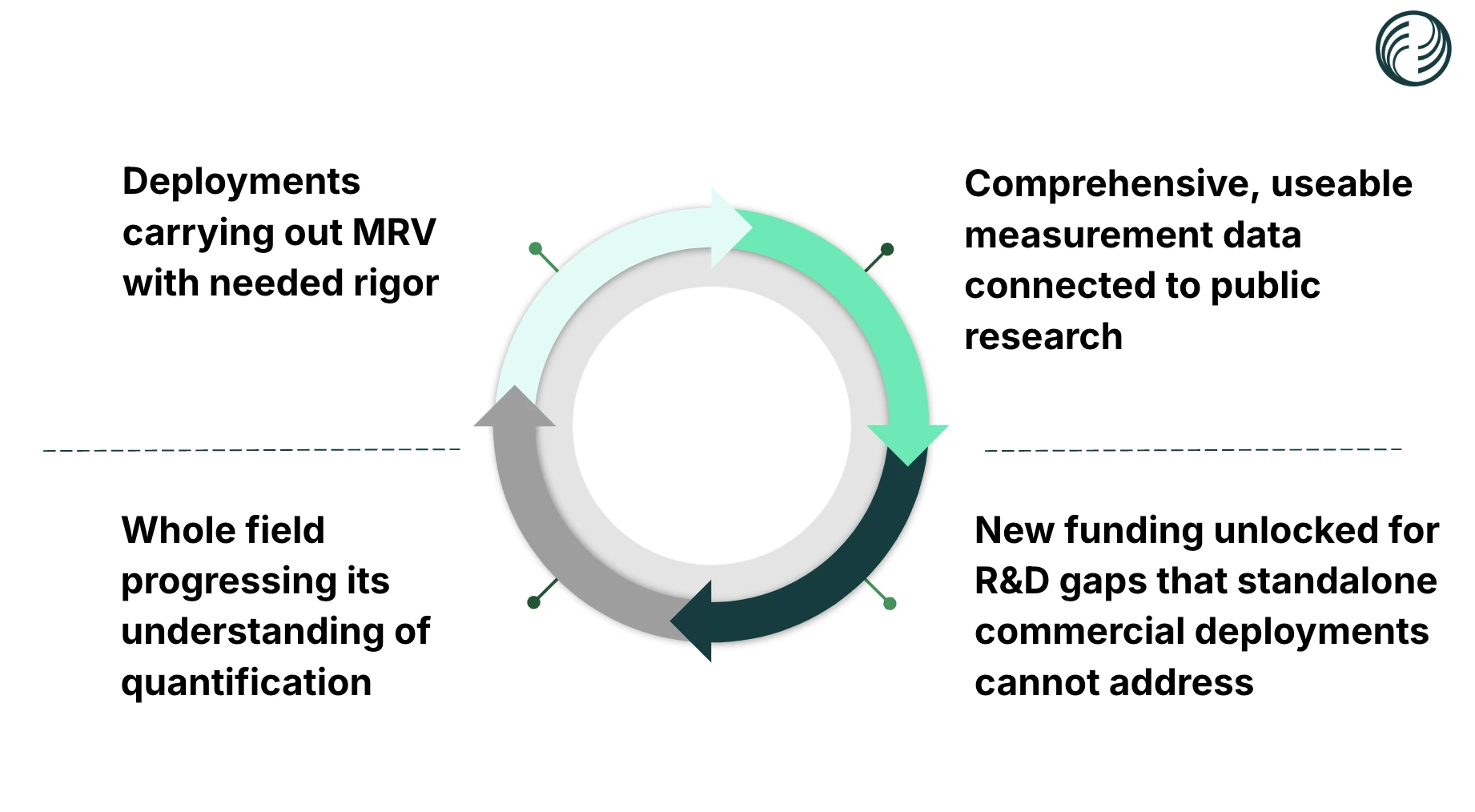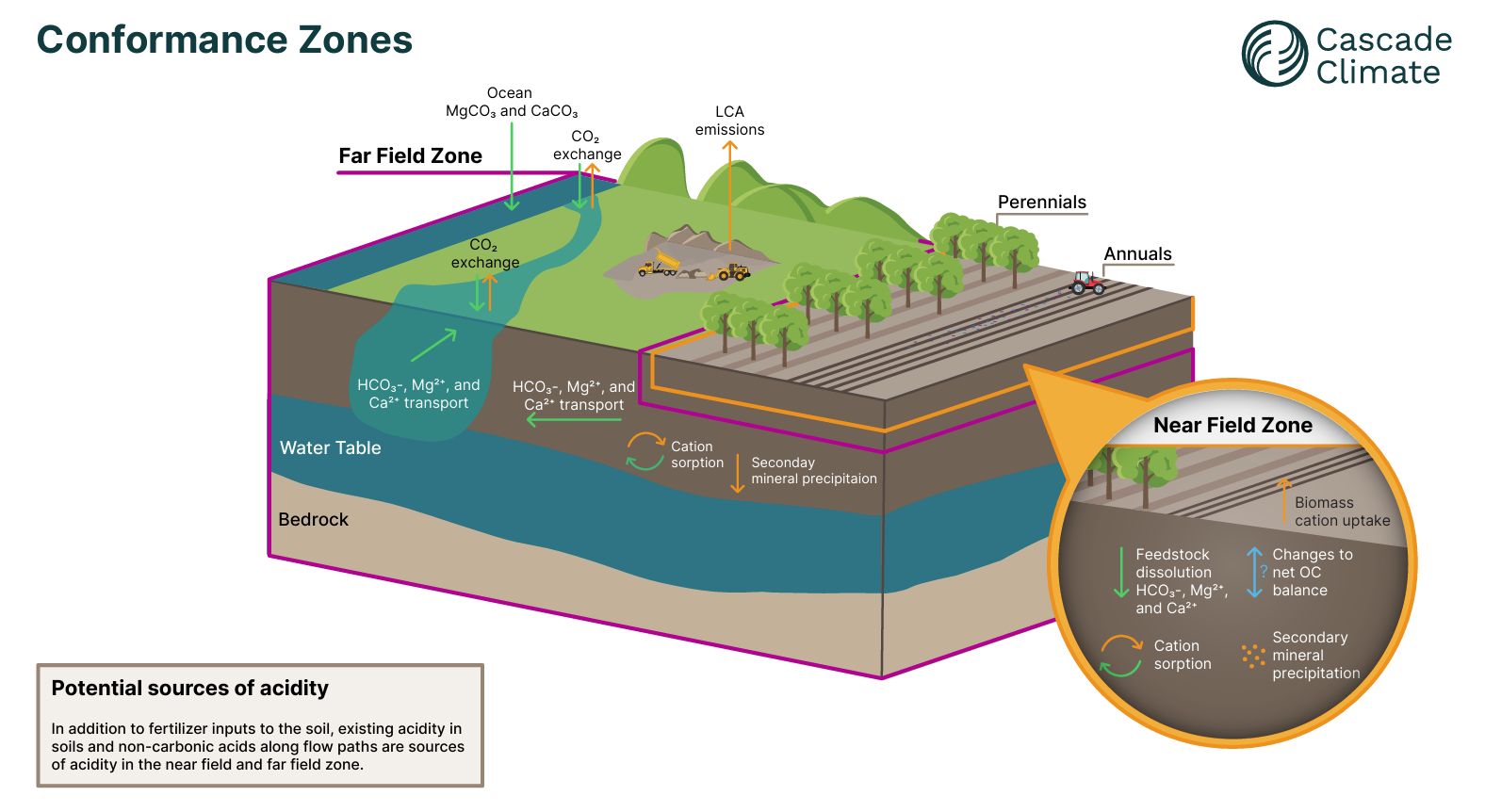Context
2023 saw an inflection point for the Enhanced Rock Weathering (ERW) field. The academic community showed a ~50% increase↗ in publications. Nearly 20 ERW project developers sprung up globally↗, conducting trials across many countries on virtually all continents. Early buyers like Frontier↗, Microsoft↗, NextGen↗, and the U.S. Department of Energy↗ committed to a first wave of catalytic offtakes. Enhanced Rock Weathering’s potential as a scalable carbon removal solution and agricultural management practice is being noticed, studied, and tested in progressively larger deployments.
As the field progresses into tens-of-thousands of hectares in cumulative scale and as the number of practitioners grows, so does the need to align on a common foundation for carbon removal quantification. In the absence of this common core, underaligned quantification rigor would pose the risk of fragmenting quality tiers and result in the emergence of commercial practices incongruent with the state of science.
Today, Cascade is thrilled to announce the publication of Foundations for Carbon Dioxide Removal Quantification in ERW Deployments. By establishing this common foundation, we aim to steer early deployments to take on the needed level of site characterization, direct measurements, and quantification rigor—the first of many steps in unlocking a cycle of faster and more efficient deployment-led learning.
Deployment-Led Learning Cycle

The virtuous cycle of deployment-led learning goes like this —— from top left, in clockwise direction:
Early ERW deployments incorporate “Foundations” guidance into their MRV design, thereby maximizing the learning value for every dollar spent.
Learning is further accelerated through building a norm across practitioners to share their quantification approaches and underlying data.
In addition to that, research priorities identified in “Foundations” can serve as a basis for a new wave of publicly and philanthropically-funded studies to address gaps that stand-alone commercial deployments are not positioned to address.
All of the above can enable the field as a whole to advance our understanding of the science and practices underpinning quantification, and of ERW’s promise as a carbon removal approach.
“Foundations” is the first step in this deployment-led learning cycle. We developed a framework for CDR quantification in ERW deployments, distilled the best available science, and produced a thick set of guidance on the “hows and whys” of rigorous quantification.
Highest-level learnings on the “hows and whys” of rigorous ERW quantification
There are three parts of the system for an end-to-end quantification of an ERW deployment:
Life cycle emissions: These are primarily, though not limited to, activities to extract the feedstock materials, and haul and spread them on soils.
Near-Field Zone (NFZ): The upper soil region where the ERW deployment must be directly tracked through measurements.
Far-Field Zone (FFZ): The transport path of the weathering flux from leaving the NFZ, through the full soil profile and into groundwater flow paths, river systems, and ultimately the ocean.

The single most important step in CDR monitoring and quantification is to “know your system and measure accordingly”. Practitioners should do an initial site characterization study of soil parameters, hydrologic regimes, crop systems, historic pH control practices, flow paths, and similar factors that could impact net carbon drawdown. Then, practitioners can design quantification methodologies and justify measurement choices based on that.
Quantifying net carbon removal involves combining data from many different imperfect “windows into the system”—geochemical measurements, tracers, and models—in seeking to assemble a comprehensive picture of the full set of carbon and cation fluxes. We can learn a lot about the system through measurements– but what is even more critical is the sharing of the underlying data to advance public research. Through data sharing, the ERW field can truly unlock the deployment-led learning cycle.
MRV planning can be challenging in practice, and significant care and expertise needs to go into doing it well. For example:
Soil systems are spatially heterogeneous and sampling depth and density needs to account for the particularities of each soil system, including the baseline variability of the parameters being measured. Practitioners should quantify the uncertainty of their CDR estimate using rigorous statistical inference methods.
There is a time lag between rocks being spread, rocks being dissolved in soils, and then carbon removal effectively occurs. Tracking needs to be done over time for us to understand all the time dynamics.
ERW application is a shift to business-as-usual agronomic practices. Therefore, netCDR in ERW deployments should be compared to a counterfactual baseline measured through a control plot, so that background weathering fluxes and counterfactual agronomic management practices are monitored and subtracted in netCDR quantification.
So, how do we go about quantifying a deployment today?
In the Near Field Zone, there are two primary approaches for measurements:
Aqueous-phase measurements of dissolved weathering products or dissolved inorganic carbon that is produced and exported from the NFZ, or in drainage waters or downstream catchments.
Solid-phase measurements of cations released through feedstock dissolution, with deductions then taken to account for the various permanent and temporary carbon and cation loss pathways within the NFZ: non-carbonic acid weathering, cation sorption, secondary carbonates, secondary silicates and biomass uptake.
It is a key research priority to intercompare aqueous phase monitoring with solid-phase mass balance results for the same deployment - when taken over the same depth, they should theoretically be producing the same results!
An additional flux we need to keep our eyes on in the NFZ is how soil organic carbon (SOC) stocks are impacted by ERW deployments. SOC monitoring on a small percentage of a deployment, and the sharing of the associated dataset, can advance research and help reduce potential SOC destabilization risks.
Constraining Far-Field Zone fluxes is an area of active research—it is challenging to do direct empirical monitoring over the spatial and time scales of the FFZ, and our ability to predictively model these fluxes is nascent. At this stage, the most tractable fluxes for near-term deployments to estimate include outgassing due to DIC equilibration and carbonate mineral precipitation (and burial) in rivers, as well as evasion due to carbonic acid system equilibration where terrestrial water mixes with the surface oceans.
Looking forward
We intend for the “Foundations” document to be a jumping-off point for the ERW community to engage in a cycle of learning-by-doing. In that vein, we hope that “Foundations" will prove a valuable resource to many practitioners and researchers who set out to deploy and study ERW in the coming years.
As we got deep into the weeds of the community process that produced “Foundations," it became clear that we need to learn more before fully standardizing approaches to ERW quantification. What is needed in the near term is more real-world deployments, across a variety of settings, that take a “know your system and measure accordingly” approach. Critically, this must be combined with transparent reporting of site characterizations, quantification methods, and underlying data. Together, we can learn systematically what deployment and quantification approaches work best in different settings, building from a 'common core’ to a suite of robust, context-specific methods.
"Foundations" provides clarity around what differentiates more versus less rigorous quantification in ERW deployments in the coming years. Because commercial deployments will be one key avenue for deployment-driven learning, we are actively working with buyers, project developers, and credit issuers to incorporate "Foundations" guidance and help ensure that all methodologies and protocols are rooted in a common core of quantification rigor.
While the “Foundations” document represents an assessment at a specific moment in time, we do not intend for the outcome of this community effort to be a static assessment with fixed recommendations; instead, Cascade hopes to regularly contribute to the learning through publishing follow-on case studies and analyses that reflect progress in the science, methods and practices of ERW deployments.


